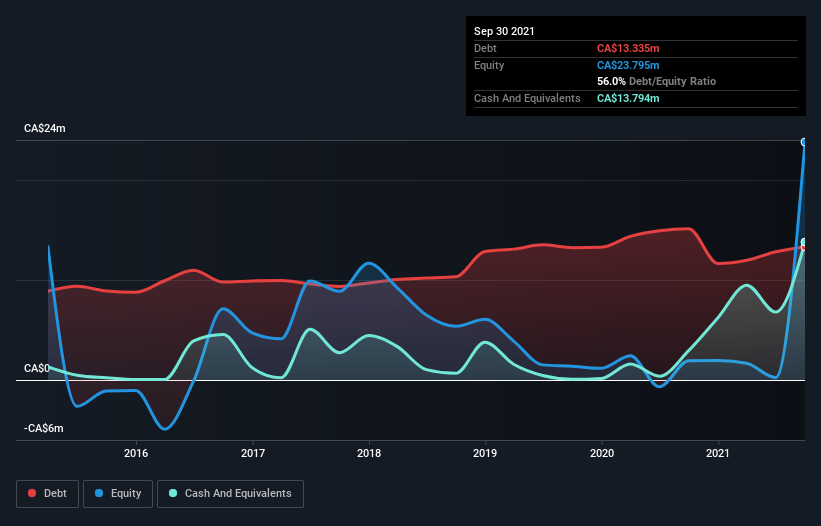- Canada
- /
- Metals and Mining
- /
- TSX:SGLD
Health Check: How Prudently Does Sabre Gold Mines (TSE:SGLD) Use Debt?

Legendary fund manager Li Lu (who Charlie Munger backed) once said, 'The biggest investment risk is not the volatility of prices, but whether you will suffer a permanent loss of capital.' So it might be obvious that you need to consider debt, when you think about how risky any given stock is, because too much debt can sink a company. As with many other companies Sabre Gold Mines Corp. (TSE:SGLD) makes use of debt. But the real question is whether this debt is making the company risky.
What Risk Does Debt Bring?
Debt and other liabilities become risky for a business when it cannot easily fulfill those obligations, either with free cash flow or by raising capital at an attractive price. Ultimately, if the company can't fulfill its legal obligations to repay debt, shareholders could walk away with nothing. However, a more frequent (but still costly) occurrence is where a company must issue shares at bargain-basement prices, permanently diluting shareholders, just to shore up its balance sheet. By replacing dilution, though, debt can be an extremely good tool for businesses that need capital to invest in growth at high rates of return. The first step when considering a company's debt levels is to consider its cash and debt together.
View our latest analysis for Sabre Gold Mines
What Is Sabre Gold Mines's Net Debt?
As you can see below, Sabre Gold Mines had CA$13.3m of debt at September 2021, down from CA$15.1m a year prior. But it also has CA$13.8m in cash to offset that, meaning it has CA$458.8k net cash.

How Strong Is Sabre Gold Mines' Balance Sheet?
We can see from the most recent balance sheet that Sabre Gold Mines had liabilities of CA$5.57m falling due within a year, and liabilities of CA$32.0m due beyond that. Offsetting this, it had CA$13.8m in cash and CA$437.8k in receivables that were due within 12 months. So its liabilities total CA$23.3m more than the combination of its cash and short-term receivables.
This is a mountain of leverage relative to its market capitalization of CA$38.0m. This suggests shareholders would be heavily diluted if the company needed to shore up its balance sheet in a hurry. Despite its noteworthy liabilities, Sabre Gold Mines boasts net cash, so it's fair to say it does not have a heavy debt load! There's no doubt that we learn most about debt from the balance sheet. But it is Sabre Gold Mines's earnings that will influence how the balance sheet holds up in the future. So if you're keen to discover more about its earnings, it might be worth checking out this graph of its long term earnings trend.
Given its lack of meaningful operating revenue, investors are probably hoping that Sabre Gold Mines finds some valuable resources, before it runs out of money.
So How Risky Is Sabre Gold Mines?
By their very nature companies that are losing money are more risky than those with a long history of profitability. And the fact is that over the last twelve months Sabre Gold Mines lost money at the earnings before interest and tax (EBIT) line. And over the same period it saw negative free cash outflow of CA$11m and booked a CA$4.2m accounting loss. Given it only has net cash of CA$458.8k, the company may need to raise more capital if it doesn't reach break-even soon. Summing up, we're a little skeptical of this one, as it seems fairly risky in the absence of free cashflow. The balance sheet is clearly the area to focus on when you are analysing debt. However, not all investment risk resides within the balance sheet - far from it. For instance, we've identified 5 warning signs for Sabre Gold Mines (3 shouldn't be ignored) you should be aware of.
If you're interested in investing in businesses that can grow profits without the burden of debt, then check out this free list of growing businesses that have net cash on the balance sheet.
New: Manage All Your Stock Portfolios in One Place
We've created the ultimate portfolio companion for stock investors, and it's free.
• Connect an unlimited number of Portfolios and see your total in one currency
• Be alerted to new Warning Signs or Risks via email or mobile
• Track the Fair Value of your stocks
Have feedback on this article? Concerned about the content? Get in touch with us directly. Alternatively, email editorial-team (at) simplywallst.com.
This article by Simply Wall St is general in nature. We provide commentary based on historical data and analyst forecasts only using an unbiased methodology and our articles are not intended to be financial advice. It does not constitute a recommendation to buy or sell any stock, and does not take account of your objectives, or your financial situation. We aim to bring you long-term focused analysis driven by fundamental data. Note that our analysis may not factor in the latest price-sensitive company announcements or qualitative material. Simply Wall St has no position in any stocks mentioned.
About TSX:SGLD
Sabre Gold Mines
Engages in the exploration and development of mineral properties.
Low and slightly overvalued.
Market Insights
Community Narratives





